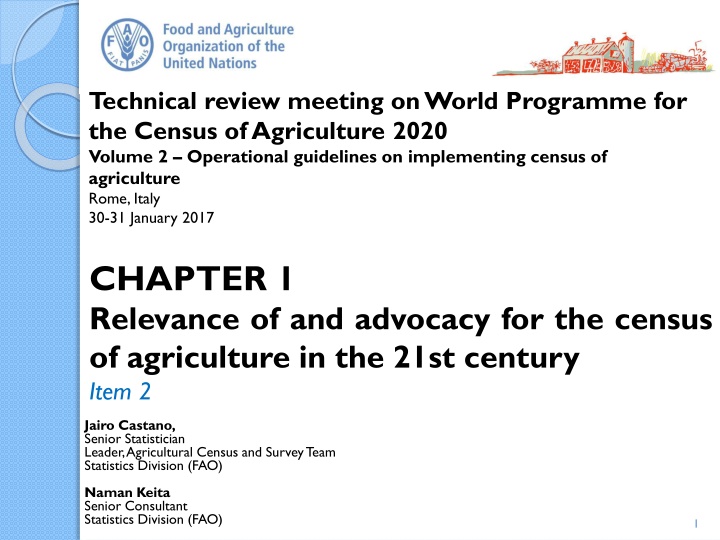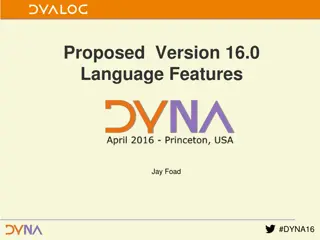
Importance and Relevance of Agricultural Census in the 21st Century
Explore the importance and uses of the agricultural census for data users and producers in supporting evidence-based decision-making, monitoring SDGs, and improving agricultural statistics. Learn about key initiatives such as the 2030 Sustainable Development Agenda and the Busan Action Plan for Statistics.
Download Presentation

Please find below an Image/Link to download the presentation.
The content on the website is provided AS IS for your information and personal use only. It may not be sold, licensed, or shared on other websites without obtaining consent from the author. If you encounter any issues during the download, it is possible that the publisher has removed the file from their server.
You are allowed to download the files provided on this website for personal or commercial use, subject to the condition that they are used lawfully. All files are the property of their respective owners.
The content on the website is provided AS IS for your information and personal use only. It may not be sold, licensed, or shared on other websites without obtaining consent from the author.
E N D
Presentation Transcript
Technical review meeting on World Programme for the Census of Agriculture 2020 Volume 2 Operational guidelines on implementing census of agriculture Rome, Italy 30-31 January 2017 CHAPTER 1 Relevance of and advocacy for the census of agriculture in the 21st century Item 2 Jairo Castano, Senior Statistician Leader, Agricultural Census and Survey Team Statistics Division (FAO) Naman Keita Senior Consultant Statistics Division (FAO) 1
CONTENT 1. Importance and relevance of the census in the 21st Century 2. Quantifying the benefit of the census of agriculture 3. Ensuring cost-effectiveness of the census of agriculture 4. Points for discussion 2
Importance and uses of the census of agriculture for data users needs: Supports evidence-based policy-making. agricultural planning and Provides data to facilitate research, investment and business decisions both in public and private sectors. Contributes to monitoring environmental changes and evaluating the impact of agricultural practices on the environment. Provides relevant data on work inputs and main work activities, as well as on the labour force in the agriculture sector. Provides information base for monitoring some key indicators of the Sustainable Development Goals (SDGs). 3
Importance and uses of the census of agriculture for data producers needs: Provides baseline data both at the national and small administrative and geographical levels for programmes and projects interventions. Provides essential information on subsistence agriculture and for the estimation of the non-observed economy. Provides a reliable benchmark for reconciling and improving current crop and livestock statistics. Provides frames for sample surveys in the agricultural survey programme, as well as information for building the Master Sample Frame. Supports the establishment or update of the statistical farm register. 4
Relevance of the census in the 21st Century The 2030 Sustainable DevelopmentAgenda: Supports monitoring of SDG 2 (end hunger, achieve food) and SDG 5 (achieve gender equality and empower all women and girls) Particularly SDG target 2.3 (productivity and income of smallholders), target 2.4 (sustainable food production systems), 5.4 (unpaid domestic work), and 5.a.1 (ownership or secure rights over agricultural land). The Busan Action Plan for Statistics WCA emphasizing the need for an integrated census and survey programme (prepared in close consultation with users) and promoting the use of new technologies as a way to improve the accessibility of statistics. 2020 supports priority areas by Busan s timeliness, reliability and 5
Relevance of the census in the 21st Century (cont d) The Global Strategy to improve agricultural and rural statistics Volume 2 builds on a wide range of existing methods, tools and publications produced during recent years, including those by the Global strategy and through other relevant initiatives such as the World Bank Living Standard Measurement Surveys/Integrated Agriculture. Surveys on 6
Quantifying the benefit of the census of agriculture (AC) - Why ? Limitations in public sector budgets imply increased pressure to justify the cost of producing statistics in general, and particularly large programmes, such as the PHC or the census of agriculture. Challenges for quantification of the benefits of statistics: statistics in themselves do not deliver benefits; it is the use of statistics that delivers benefit - through better and/or timelier decisions by governments, companies and individuals. Ensuring identification of financial terms or not) and that the plans focus on realising these benefits is a key consideration to census planning . that there the is some (in benefits However, since governments and other funding organisations need to decide spending priorities, there is a need to provide evidence to justify expenditure on the census (as opposed to other priorities). Therefore, census managers often need to go beyond just listing the possible benefits and financially quantify some of the benefits delivered in order to strengthen the case for the census. 7
Quantifying the benefit of the AC Purpose? This financial quantification of benefits (and cost benefit analysis) may be needed to: Evaluate a previous census of agriculture; Justify continuing with the census of agriculture; Appraise options for delivery (full census versus more frequent sample surveys); Justify a new/expanded census of agriculture. Cost-benefit analysis : Comparing the benefits of a (proposed) course of action to the costs in terms of net present value (NPV) or the benefit to cost ratio (the higher is the NPV, the better; and the greater the benefit to cost ratio, the better). A negative NPV, or a benefit to cost ratio of less than one would indicate that a project is not worth pursuing on economic grounds (it may make sense on other grounds 8
Quantifying the benefit of the AC Steps and techniques Main steps to financially quantify the benefits of the AC include: Identifying users and uses; Resourcing, prioritisation and planning the work; Compiling, aggregating and analysing data; Overcoming reluctance to participate. Techniques to financially quantify the benefits of the AC: Direct estimate by users: Willingness to pay Costs avoidance: Estimating value added 9
Quantifying the benefit of the AC- Process Estimate the turnover of the user group (for example, Ministries, academia, think-tanks, input suppliers, agro-industry) or value of the decisions; With sector experts, estimate the role that data as a whole contributes to the sector/industry/decisions. Of the proportion of the sector or decision s value attributable to data, estimate the proportion attributable to census of agriculture. Use these estimates to derive an estimated value for the contribution of censuses of agriculture statistics. Two types of use/decision to be considered when estimating the value of the census: Uses/decisions/businesses founded on Census data they could not happen without them. Uses/decisions that are informed by Census data to make them better but could happen without the Census. 10
Example of benefit calculation Sector Value of sector (A) Contribution of data to sector (B) Contribution of census of agriculture data - out of total data (C) Benefited attributable to census of agriculture data (Ax B x C) High usage export policy making $10m 40% 20% $ 0.8m Low usage agro- machinery supply $200 m 2% 20% $ 0.8m
Ensuring cost-effectiveness of the census of agriculture The census should be planned and carried out as inexpensively as possible without compromising the objectives and the quality of the data. The census strategy should aim at minimising costs by: (a) adopting more efficient data collection, data capture and data processing approaches and related technologies, (b) contracting out appropriate parts of the operation, (c) exploring possible sources of alternative funding and, if appropriate, developing proposals for cost recovery and income-generation, (d) international collaboration and reuse of systems, (e) encouraging public to self-complete forms online or on paper where possible, and (f) replace direct collection of data with use of administrative data 12
Main census budget components for comparing the structure of costs by country BUDGET COMPONENTS STRUCTURE (%) CENSUS MANAGEMENT 5-23 MATERIAL AND SUPPLIES 10-26 TRAINING/CAPACITY BUILDING 1-15 PUBLICITY/COMMUNICATION 2-5 FIELD DATA COLLECTION 40-60 PROCESSING/ANALYSIS 5-15 DISSEMINATION 1-3
Ensuring cost-effectiveness of the census of agriculture (cont d) Wide diversity among countries with costs ranging from around 2 US $ to above 20 US $ per holding. External factors beyond the control of census planners and managers: population density (# holdings per square km), level of salaries, existence and use of previous human and equipment infrastructure. However: field staff management and remuneration strategies seem to play an important role: a performance based salary/allowance system vs fix monthly salary system. mobilizing existing personnel and equipment (including staff for census management unit), using CAPI to reduce time spent in the field and for data processing may have an impact in reducing the cost. 14
Ensuring cost-effectiveness of the census of agriculture Example of Moldova Census planners in Moldova managed to significantly reduce the initial budget by almost 1/3. Some of the cost reduction actions included: Reducing questionnaire size and complexity for complete enumeration: Combining complete enumeration of agricultural holdings above the established thresholds with the sample enumeration of smallest agricultural producers below the thresholds. Using existing infrastructure such as buildings in local administrations and other existing equipment and personnel, including staff for the census management. Procurement of goods and payment of salaries for field staff were allocated between Donors contribution and Government contribution with the view of achieving cost reduction (e.g. exemption of value added tax, social security costs in the case of procurements/ payments from donors funds). 15
Discussion Points Relevance of the new sections on importance, relevance, quantification of benefits and cost effectiveness of the census? How can they be improved to be useful for census planners? Are the charts useful? 16
THANK YOU 17





















